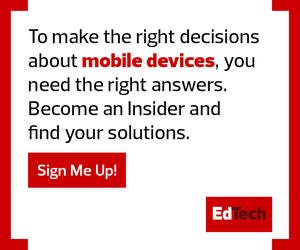In the 21st century, it can feel like advanced technology is changing the K–12 classroom in ways we’ve never seen before. But the truth is, technology and education have a long history of evolving together to dramatically change how students learn.
With more innovations surely headed our way, why not look back at how we got to where we are today, while looking forward to how educators can continue to integrate new technologies into their learning?
DISCOVER: Special education departments explore advanced tech in their classrooms.
Using Technology in the K–12 Classroom: A History
1659: Magic Lantern
- Inventor: Christiaan Huygens
- A Brief History: An ancestor of the slide projector, the magic lantern projected glass slides with light from oil lamps or candles. In the 1680s, the technology was brought to the education space to show detailed anatomical illustrations, which were difficult to sketch on a chalkboard.
- Interesting Fact: Huygens initially regretted his creation, thinking it was too frivolous.
1795: Pencil
- Inventor: Nicolas-Jacques Conté
- A Brief History: Versions of the pencil can be traced back hundreds of years, but what’s considered the modern pencil is credited to Conté, a scientist in Napoleon Bonaparte’s army. It made its impact on the classroom, however, when it began to be mass produced in the 1900s.
- Interesting Fact: The Aztecs used a form of graphite pencil in the 13th century.
1801: Chalkboard
- Inventor: James Pillans
- A Brief History: Pillans — a headmaster at a high school in Edinburgh, Scotland — created the first front-of-class chalkboard, or “blackboard,” to better teach his students geography with large maps. Prior to his creation, educators worked with students on smaller, individual pieces of wood or slate. In the 1960s, the creation was upgraded to a green board, which became a familiar fixture in every classroom.
- Interesting Fact: Before chalkboards were commercially manufactured, some were made do-it-yourself-style with ingredients like pine board, egg whites and charred potatoes.
1888: Ballpoint Pen
- Inventory: John L. Loud
- A Brief History: John L. Loud invented and patented the first ballpoint pen after seeking to create a tool that could write on leather. It was not a commercial success. Fifty years later, following the lapse of Loud’s patent, Hungarian journalist László Bíró invented a pen with a quick-drying special ink that wouldn’t smear thanks to a rolling ball in its nib.
- Interesting Fact: When ballpoint pens debuted in the U.S., they were so popular that Gimbels, the department store selling them, made $81 million in today’s money within six months.
LEARN MORE: Logitech Pen works with Chromebooks to combine digital and physical learning.
1950s: Overhead Projector
- Inventor: Roger Appeldorn
- A Brief History: Overhead projects were used during World War II for mission briefings. However, 3M employee Appeldorn is credited with creating not only a projectable transparent film, but also the overhead projectors that would find a home in classrooms for decades.
- Interesting Fact: Appeldorn’s creation is the predecessor to today’s bright and efficient laser projectors.
1959: Photocopier
- Inventor: Chester Carlson
- A Brief History: Because of his arthritis, patent attorney and inventor Carlson wanted to create a less painful alternative to making carbon copies. Between 1938 and 1947, working with The Haloid Photographic Company, Carlson perfected the process of electrophotography, which led to development of the first photocopy machines.
- Interesting Fact: Haloid and Carlson named their photocopying process xerography, which means “dry writing” in Greek. Eventually, Haloid renamed its company (and its flagship product line) Xerox.
1967: Handheld Calculator
- Inventor: Texas Instruments
- A Brief History: As recounted in our history of the calculator, Texas Instruments made calculators portable with a device that weighed 45 ounces and featured a small keyboard with 18 keys and a visual display of 12 decimal digits.
- Interesting Fact: The original 1967 prototype of the device can be found in the Smithsonian Institution’s National Museum of American History.
1981: The Osborne 1 Laptop
- Inventor: Adam Osborne, Lee Felsenstein
- A Brief History: Osborne, a computer book author, teamed up with computer engineer Felsenstein to create a portable computer that would appeal to general consumers. In the process, they provided the technological foundation that made modern one-to-one devices — like Chromebooks — a classroom staple.
- Interesting Fact: At 24.5 pounds, the Osborne 1 was about as big and heavy as a sewing machine, earning it the current classification of a “luggable” computer, rather than a laptop.
1990: World Wide Web
- Inventor: Tim Berners-Lee
- A Brief History: In the late 1980s, British scientist Berners-Lee created the World Wide Web to enable information sharing between scientists and academics. It wasn’t long before the Web could connect anyone, anywhere to a wealth of information, and it was soon on its way to powering the modern classroom.
- Interesting Fact: The first web server Berners-Lee created was so new, he had to put a sign on the computer that read, “This machine is a server. DO NOT POWER IT DOWN!”
Click the banner to access customized K–12 technology content when you sign up as an Insider.
What Technology Is Used in Today’s K–12 Classrooms?
Technology has come so far that modern classrooms are more technologically advanced than many science labs were two decades ago. Students have access to digital textbooks, personal devices, collaborative cloud-based tools, and interactive whiteboards. Emerging technologies now being introduced to K–12 classrooms include voice assistants, virtual reality devices and 3D printers.
Perhaps the most important thing about ed tech in K–12 isn’t what the technology is, but how it’s used.
How to Integrate Technology into K–12 Classrooms
The first step to integrating technology into the K–12 classroom is figuring out which solution to integrate, given the large variety of tools available to educators. That variety comes with benefits — like the ability to align tech with district objectives and grade level — but also brings challenges.
“It’s difficult to know how to choose the appropriate digital tool or resource,” says Judi Harris, professor and Pavey Family Chair in Educational Technology at the William & Mary School of Education. “Teachers need some familiarity with the tools so that they understand the potential advantages and disadvantages.”
K–12 IT leaders should also be careful not to focus too much on technology implementation at the expense of curriculum-based learning needs. “What districts need to ask themselves is not only whether they’re going to adopt a technology, but how they’re going to adopt it,” says Royce Kimmons, associate professor of instructional psychology and technology at Brigham Young University.
In other words, while emerging technologies may be exciting, acquiring them without proper consideration of their role in improving classroom learning will likely result in mixed student outcomes. For effective integration, educators should ask themselves, in what ways would the tech increase or support a student’s productivity and learning outcomes? How will it improve engagement?
Integrating ed tech also requires some practical know-how. “Teachers need to be comfortable and confident with the tools they ask students to use,” says Harris.
Professional development for new technologies is crucial, as are supportive IT teams, tech providers with generous onboarding programs and technology integration specialists. Harris also points to initiatives like YES: Youth and Educators Succeeding, a nonprofit organization that prepares students to act as resident experts and classroom IT support.
KEEP READING: What is the continued importance of professional development in K–12 education?
But as educational technology is rolled out and integrated, it’s important to keep academic goals in sight. “We should never stop focusing on how to best understand and help the learner to achieve those learning objectives,” says Harris.
That should continue to be the case as the technology timeline unfolds, something Harris has witnessed firsthand during her four decades in the field. “It’s been an incredible thing to watch and to participate in,” she notes. “The great majority of teachers are extremely eager to learn and to do anything that will help their students learn better.”












